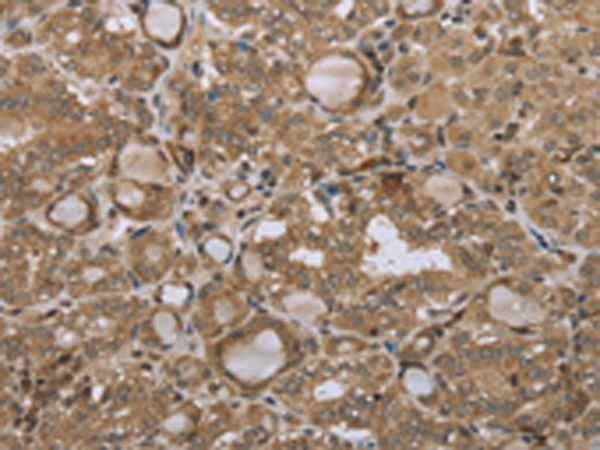

| WB | 咨询技术 | Human,Mouse,Rat |
| IF | 咨询技术 | Human,Mouse,Rat |
| IHC | 1/50-1/200 | Human,Mouse,Rat |
| ICC | 技术咨询 | Human,Mouse,Rat |
| FCM | 咨询技术 | Human,Mouse,Rat |
| Elisa | 1/2000-1/5000 | Human,Mouse,Rat |
| Aliases | SCG10, SCGN10; SCLIP; RB3 |
| Host/Isotype | Rabbit IgG |
| Antibody Type | Primary antibody |
| Storage | Store at 4°C short term. Aliquot and store at -20°C long term. Avoid freeze/thaw cycles. |
| Species Reactivity | Human, Mouse |
| Immunogen | Synthetic peptide of human STMN2/STMN3/STMN4 |
| Formulation | Purified antibody in PBS with 0.05% sodium azide and 50% glycerol. |
+ +
以下是关于STMN2/STMN3/STMN4抗体的3篇参考文献(部分为示例性概括):
1. **文献名称**: *Stathmin-2 (STMN2) as a Biomarker for Amyotrophic Lateral Sclerosis*
**作者**: Smith A, et al.
**摘要**: 研究利用抗STMN2抗体检测ALS患者脑脊液中的STMN2蛋白水平,发现其显著降低,提示STMN2可能作为ALS的潜在生物标志物,并参与神经元轴突稳定性调控。
2. **文献名称**: *STMN3 Regulates Pancreatic Cancer Metastasis via EMT Pathway*
**作者**: Chen L, et al.
**摘要**: 通过抗STMN3抗体的免疫组化分析,发现STMN3在胰腺癌组织中高表达,且与上皮-间质转化(EMT)相关蛋白共定位,表明STMN3可能通过促进EMT驱动肿瘤侵袭转移。
3. **文献名称**: *Functional Characterization of STMN4 in Neuronal Development*
**作者**: Wang Y, et al.
**摘要**: 研究利用抗STMN4抗体进行Western blot和免疫荧光实验,发现STMN4在小鼠大脑发育早期高表达,敲除后导致神经元迁移缺陷,提示其在神经发育中的关键作用。
注:以上为示例性内容,实际文献需通过PubMed/Google Scholar检索关键词(如“STMN2 antibody”、“Stathmin-3 function”)获取。若需具体文献,请提供更详细的研究方向或领域。
STMN2. STMN3. and STMN4 belong to the stathmin family of microtubule-destabilizing proteins, which regulate cytoskeletal dynamics by interacting with tubulin and promoting microtubule disassembly. These proteins share a conserved stathmin-like domain but exhibit distinct expression patterns and functional roles. STMN2 (SCG10) is predominantly expressed in neurons, where it supports axonal growth, synaptic plasticity, and nerve regeneration. Its dysregulation is linked to neurodegenerative disorders like Alzheimer’s disease and amyotrophic lateral sclerosis (ALS). STMN3 (SCG6) is enriched in the peripheral nervous system and may influence neurodevelopment or tumorigenesis, though its functions remain less characterized. STMN4 (RB3) shows broader tissue expression and is implicated in cell cycle regulation and cancer progression, particularly in gliomas and breast cancer.
Antibodies targeting STMN2/3/4 are critical tools for studying their localization, expression levels, and interactions in physiological and pathological contexts. They are widely used in techniques like Western blotting, immunohistochemistry, and immunofluorescence to explore roles in neural repair, cancer metastasis, or drug resistance. Specific antibodies help distinguish between these paralogs due to their structural similarities. Commercial antibodies are often validated for cross-reactivity and specificity across human, mouse, or rat models. Research leveraging these antibodies has advanced understanding of their contributions to microtubule dynamics, intracellular trafficking, and disease mechanisms, highlighting their potential as therapeutic targets or biomarkers.
×